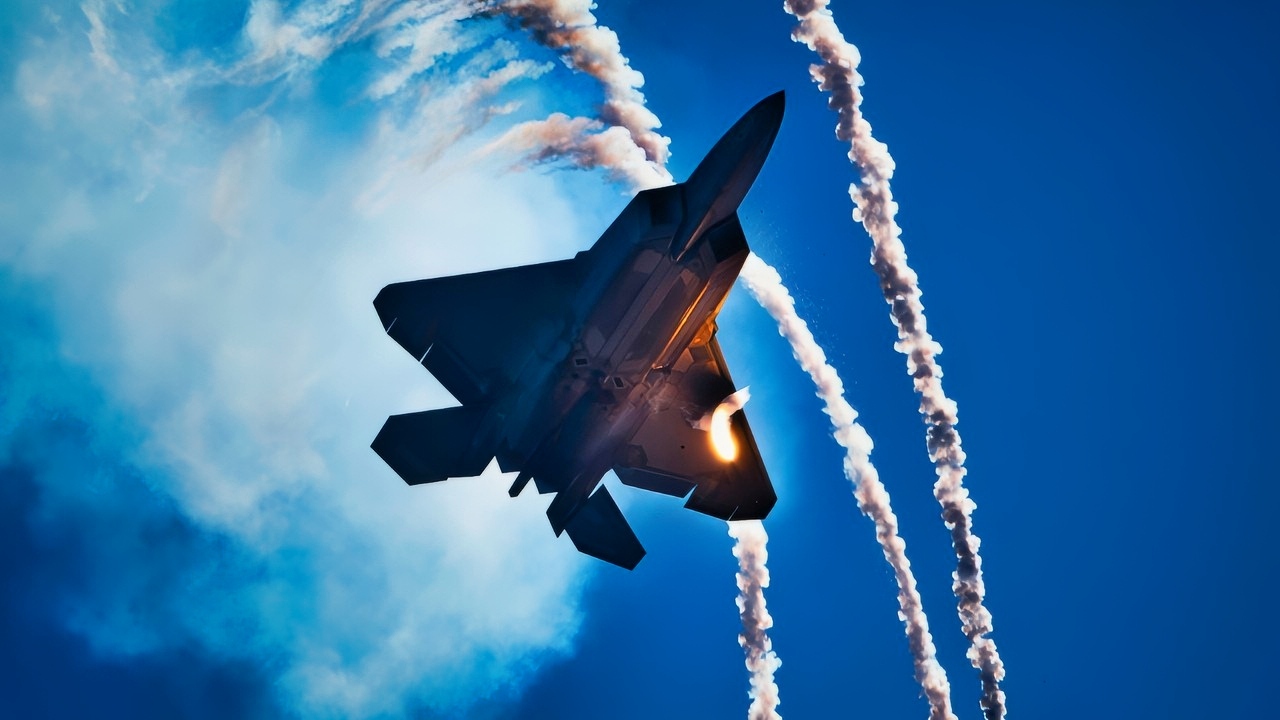Key Points and Summary – U.S.–Iran antagonism did not begin with this June’s B-2 strikes. In 2013, after Iranian jets harassed U.S. MQ-1 flights in international airspace, the Pentagon began escorting drones with fighters.
-During one mission, two Iranian F-4 Phantoms closed on a Predator—until an F-22 Raptor flown by Lt. Col. Kevin “Showtime” Sutterfield slid unseen beneath them, verified their loads, then pulled alongside with a radio warning: “You really ought to go home.”

U.S. Air Force Maj. Josh Gunderson, F-22 Demo Team commander, enters into the Raptor Slide during the Millville Airshow, Sept. 3, 2021, at Millville Army Airfield, Millville, New Jersey. During the Raptor Slide the aircraft actually slides down and backwards under control before Gunderson adjusts the aircrafts position and powers out of the maneuver. (U.S. Air Force photo by Staff Sgt. Don Hudson)
-They did. The episode—later recounted by USAF leadership and immortalized in art—highlights a long pattern of aerial brinkmanship and helps frame today’s debates over B-2 raids, deterrence, and escalation.
F-22 vs. Iran’s Old F-4 Phantom Fighters
The U.S. and Iran have been adversaries for a very long time – long before U.S. B-2 bombers struck Iran’s nuclear facilities this June.
The Iranian hostage crisis in 1979 helped bring about the end of Jimmy Carter’s presidency, and Iran often involved itself in the Iraq War to oppose U.S. interests in that country.
On June 22 this year, U.S. B-2 bombers struck Iran’s nuclear facilities with bunker-buster bombs. The operation came after more than a week of Israeli attacks on Iran. U.S. President Donald Trump said after the bombing that Iran’s nuclear facilities had been “obliterated,” although subsequent reporting citing post-action intelligence reports has cast doubt on those claims.
But more than a decade before this year’s mission to strike Iran’s nuclear facilities, there was another confrontation, strictly in the air, between U.S. and Iranian fighter jets.
It’s Showtime: F-22 vs. Iran
According to an account published in Sandboxx in 2021, the incident took place in 2013, when a pair of Iranian fighter pilots were “closing with an American drone in international airspace.”
The previous November, in a separate incident, two Revolutionary Guard Corps Su-25 Frogfoot attack aircraft saw an MQ-1 Predator drone flying in international waters off the coast of Iran. They opened fire, but the drone remained intact. At that point, the Su-25s broke off, likely having exhausted their rounds.
After that encounter, according to Sandboxx, the U.S. started using fighter escorts to accompany such drone flights. F/A-18E/F Super Hornets undertook some of these escort flights, but at other times F-22 Raptors took up the task.
The famed incident took place in March of 2013. An MQ-1 Predator drone was once again conducting reconnaissance off the coast of Iran, but in international waters. Two Iranian fighters, this time F-4 Phantoms, spotted the drone, approached, and prepared to fire.
But as the Iranian fighters got set to launch their payloads, an F-22 arrived, piloted by Lt. Col. Kevin “Showtime” Sutterfield. His jet flew under the Iranian fighters to examine their weapons, and thanks to the Raptor’s stealth capabilities, it remained unseen.
Showtime pulled up next to the surprised Iranian pilots, got on his radio, and stated, “You really ought to go home.” The F-4 pilots did just that.
The Flight’s Legacy
There were public reports about the confrontation almost immediately. In September, Chief of Staff Gen. Mark Welsh “sketched out” the tale at that year’s Air Force Association’s Air & Space Conference and Technology Exposition, as reported by Military.com.
“When the combatant commander wants air power there is only one number to call,” Welsh said of Lt. Col. Kevin “Showtime” Sutterfield. “Showtime is an Air Force Reservist…he flies the F-22. He flies it really well.”

F-4 Phantom Images Original National Security Journal.

F-4 Phantom Fighter National Security Journal. Image Taken on August 23, 2025.
According to that report, the 2013 confrontation came at a time when the “Air Force was forced to repeatedly halt F-22 flights because F-22 pilots repeatedly reported blacking out from breathing problems.”
The incident was immortalized in an oil painting the following year by Lt. Col. Warren Neary..
Deployed Again?
Back to this year: In June, a few days before the U.S. attacked Iran’s nuclear sites but at a time when the president was said to be weighing just such an operation, multiple F-22 Raptors landed at RAF Lakenheath in England, Air and Space Forces reported.
The F-22, that report said, “has often been mobilized in times of tension with Iran,” including in August of 2024, when Hamas leader Ismail Haniyeh was killed while he was in Iran.
However, it was always clear that if the United States attacked the Iranian sites – especially the ones that required bunker-buster bombers – B-2s would carry out the operation. That is indeed what ended up happening, with the bombers taking off from the U.S., flying all the way to Iran, returning back home. However, it was the F-22 Raptor that most likely escorted the B-2 bomber into hostile territory.
About the Author: Stephen Silver
Stephen Silver is an award-winning journalist, essayist, and film critic, and contributor to the Philadelphia Inquirer, the Jewish Telegraphic Agency, Broad Street Review, and Splice Today. The co-founder of the Philadelphia Film Critics Circle, Stephen lives in suburban Philadelphia with his wife and two sons. For over a decade, Stephen has authored thousands of articles that focus on politics, national security, technology, and the economy. Follow him on X (formerly Twitter) at @StephenSilver, and subscribe to his Substack newsletter.
More Military
The Air Force’s F-16XL Fighter-Bomber Mistake Still Hurts
How Do You Replace the Aircraft Carrier?
SR-72 Son of Blackbird Could Transform the U.S. Military










